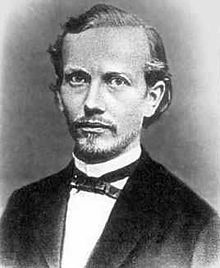Hermann Hankel
Hermann Hankel (born February 14, 1839 in Halle (Saale) , † August 29, 1873 in Schramberg ) was a German mathematician . He is known for the Hankel transformation named after him and the Hankel matrix .
Life
Hankel was the son of physics professor Wilhelm Gottlieb Hankel . In 1849 the family moved to Leipzig, where he attended the Nicolaischule and, thanks to his good performance in mathematics in the upper school, was given permission to read the original Greek mathematicians instead of the usual classics. He studied with August Ferdinand Möbius , Wilhelm Scheibner and his father in Leipzig, Bernhard Riemann in Göttingen (1860) and with Karl Weierstrass and Leopold Kronecker in Berlin. As early as 1861 he solved a prize task in Göttingen with a thesis on Helmholtz vortex theory, and he received his doctorate with a thesis on the development of series in continued fractions (which he attributed to the investigation of special matrices that have the same elements in a counter-diagonal ) 1862 in Leipzig. During his student days, there were already signs of a serious illness.
In 1867 he became an associate professor in Leipzig, but in the same year he received an appointment as a full professor in Erlangen. There he married Marie Dippe and in 1869 took a chair in Tübingen, where the passionate academic teacher hoped to attract more students. He reformed the mathematics teaching there by founding the mathematics seminar together with Sigmund Gundelfinger and a few other colleagues. Since then he has devoted himself intensively to teaching.
In his “ Principle of the Permanence of Formal Laws ” (1867) and his “ Theory of Complex Number Systems ” (1867) he examined algebras such as complex, real numbers, quaternions and the algebraic systems used in geometry by Möbius and Hermann Günther Graßmann , whose importance he was one of the first to recognize. These investigations were actually intended as a preliminary stage to a textbook on function theory , which he could no longer complete. In 1870 only one book appeared on real functions, which ties in with the corresponding investigations by Riemann. His lectures on projective geometry were also published after his death.
Special cylinder functions , the Hankel functions , are named after him, as is the Hankel transformation he studied . Further work concerns the Riemann integration theory.
In the summer of 1872 he fell ill with meningitis, from which he almost died. After he had always taken up the historical side of the respective topic in his other works and after his active time as a researching mathematician was planning to write a larger work on the history of mathematics, he gave an initial outline in a book published in 1874 on request. The work is unfinished, however, because he fell seriously ill again and succumbed to a stroke on a vacation trip to the Black Forest.
Works
Besides the books mentioned above:
- Euler's integrals with unlimited variability of the argument habilitation dissertation, in commission at Leopold Voss, Leipzig 1863
- A contribution to the assessment of the natural sciences of ancient Greece , Deutsche Vierteljahresschrift Vol. 4, 1867, pp. 120–155
- Theory of complex number systems (lectures on complex numbers and their functions, part 1) , Leopold Voss, Leipzig, 1867
- The Development of Mathematics in the Last Centuries . L. Fr. Fues'sche Assortment Bookshop, Tübingen, 1869
- The cylinder functions of the first and second kind , Mathematische Annalen, 1869, p. 467, online here: [1]
- Investigations into the infinitely often oscillating and discontinuous functions . Tubingen 1870
- On the history of mathematics in antiquity and the Middle Ages . Teubner, Leipzig 1874.
- Axel Harnack (Ed.): The elements of projective geometry in synthetic treatment . Lectures, BG Teubner, Leipzig 1875
- Article Gravitation , Limit , Lagrange's theorem ( theory of equations) in Verlag, Gruber (Hrsg.) "Allgemeine Enzyklopädie der Wissenschaften und Künste", 1818 ff online here: Article Gravitation
See also
Web links
- Literature by and about Hermann Hankel in the catalog of the German National Library
- John J. O'Connor, Edmund F. Robertson : Hermann Hankel. In: MacTutor History of Mathematics archive .
- Overview of Hermann Hankel's courses at the University of Leipzig (summer semester 1863 to summer semester 1867)
- Hankel encyclopedia article "Limit"
- Digitized works by Hankel ( Memento of July 31, 2010 in the Internet Archive ) - SICD of the Universities of Strasbourg
literature
- Josef Lense : Hankel, Hermann. In: New German Biography (NDB). Volume 7, Duncker & Humblot, Berlin 1966, ISBN 3-428-00188-5 , p. 618 f. ( Digitized version ).
- Moritz Cantor : Hankel, Hermann . In: Allgemeine Deutsche Biographie (ADB). Volume 10, Duncker & Humblot, Leipzig 1879, pp. 516-519.
- Wilhelm von Zahn : A few words in memory of Hermann Hankel. In: Mathematische Annalen 7 (1874), p. 583-590 ( online ).
| personal data | |
|---|---|
| SURNAME | Hankel, Hermann |
| BRIEF DESCRIPTION | German mathematician |
| DATE OF BIRTH | February 14, 1839 |
| PLACE OF BIRTH | Halle (Saale) |
| DATE OF DEATH | August 29, 1873 |
| Place of death | Schramberg |
